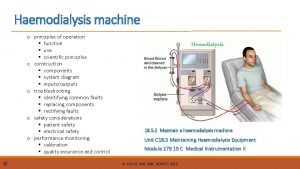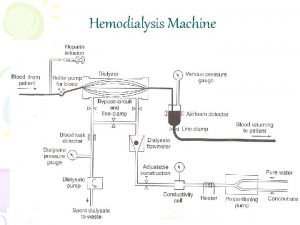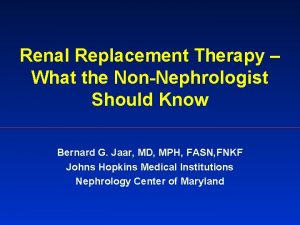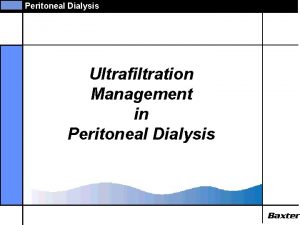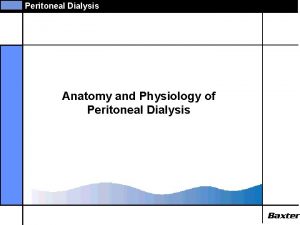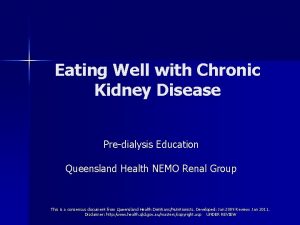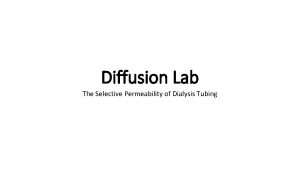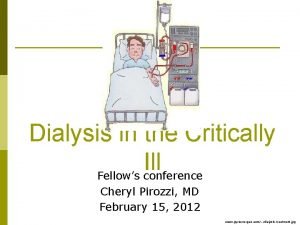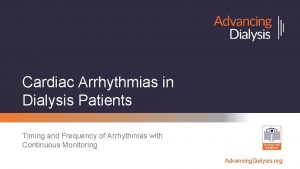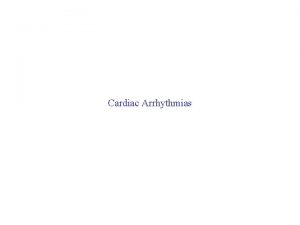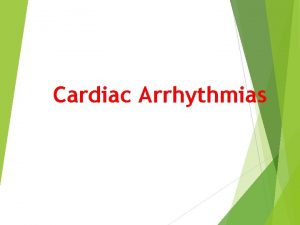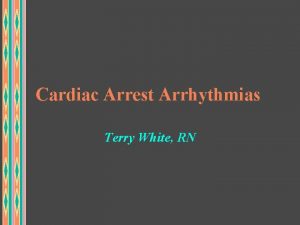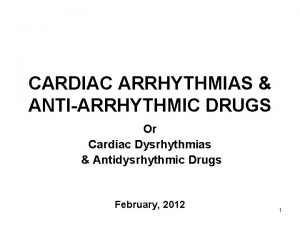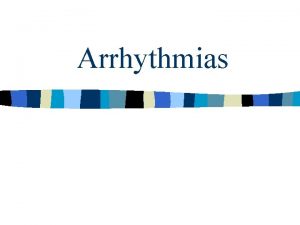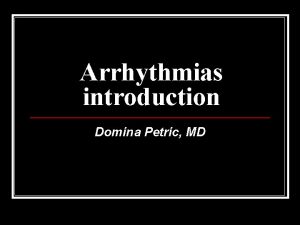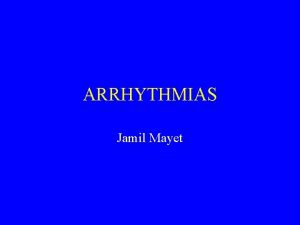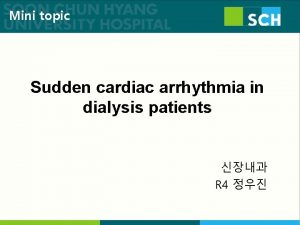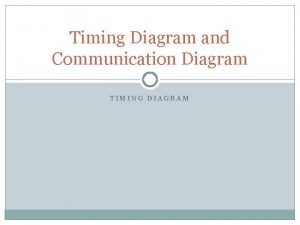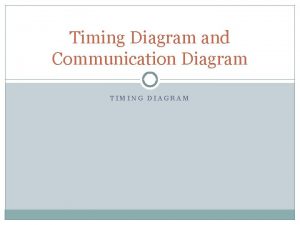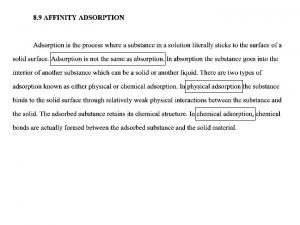Cardiac Arrhythmias in Dialysis Patients Timing and Frequency
















- Slides: 16

Cardiac Arrhythmias in Dialysis Patients Timing and Frequency of Arrhythmias with Continuous Monitoring Advancing. Dialysis. org

Increased risk of sudden cardiac death in dialysis patients 1 • Decreased GFR has been suggested to cause endocardial and diffuse myocardial fibrosis that could increase the risk of lifethreatening ventricular arrhythmias and sudden cardiac death (SCD)2 • Each 10 ml/min decline in e. GFR has been associated with an 11% increased risk of SCD 1 RATES OF SUDDEN CARDIAC DEATH IN SELECTED POPULATIONS 1, 3 Dialysis 24. 2 CKD stage III, IV 7. 3 CVD, GFR >60 3. 8 General population 1 1 Pun, P. H. et al. Chronic kidney disease is associated with increased risk of sudden cardiac death among patients with coronary artery disease. Kidney International (2009) 76, 652– 658. 2 Mark PB, Johnston N, Groenning BA et al. Redefinition of uremic cardiomyopathy by contrast-enhanced cardiac magnetic resonance imaging. Kidney Int 2006; 69: 1839– 1845. 3 Hayashi M. , Shimizu W. , Albert C. M. The Spectrum of Epidemiology Underlying Sudden Cardiac Death. Circulation Research. 2015; 116: 1887 -1906 CKD stage V, ND 12. 6 0 5 10 15 20 25 Events per 1000 patient years Advancing. Dialysis. org 30

No recent progress in sudden cardiac death 1 One-year Cardiovascular Mortality Rates in Adult Patients by Primary Cause of Death Monitoring in Dialysis (Mi. D) Study • 6 -months of follow-up Deaths per 100 patient-years • Aimed to estimate the proportion of thriceweekly hemodialysis patients who experienced clinically significant arrhythmias according to death notification form 7 Sudden cardiac death 6 5 4 3 2 Acute myocardial infarction 1 0 2004 2005 2006 2007 2008 2009 2010 2011 2012 2013 1 Wetmore JB, Gilbertson DT, Liu J, Collins AJ. Improving outcomes in patients receiving dialysis: The Peer Kidney Care Initiative, Clin J Am Soc Nephrol. 2016 Jul 7; 11(7): 1297 -304. Figure 4. 5. Advancing. Dialysis. org

Clinically significant arrhythmias were defined prospectively and examined 1 Ventricular tachycardia ≥ 130 beats per minute for ≥ 30 seconds Bradycardia ≤ 40 beats per minute for ≥ 6 seconds Asystole for ≥ 3 seconds Symptomatic events with electrocardiography-confirmed arrhythmia 66 patients enrolled; 62 (94%) completed 6 months of follow-up and the devices also detected atrial fibrillation 1 Charytan, D. M. , et al. Arrhythmia and Sudden Death in Hemodialysis Patients: Protocol and Baseline Characteristics of the Monitoring in Dialysis Study. Clin J Am Soc Nephrol. 2016; 11: 721– 734 Advancing. Dialysis. org

2/3 patients experienced clinically significant arrhythmias 1 • Incidence rate of clinically significant arrhythmias was 4. 5 events per patient-month (1, 678 events) ‒ Leading arrhythmia was bradycardia • 3. 9 events per patientmonth ‒ Significantly lower rate of ventricular tachycardia or asystole 1 Roy-Chaudhury, P. , et al. Primary outcomes of the Monitoring in Dialysis Study indicate that clinically significant arrhythmias are common in hemodialysis patients and related to dialytic cycle. Kidney Int. 2018; 93: 941– 951. Advancing. Dialysis. org

Clear time-based patters of clinically significant arrhythmias 1 • Highest during the first hemodialysis session of the week • 2 nd-highest during the final 12 hours of the long interdialytic gap • 3 rd-highest during the 12 hours immediately following the first session of the week • Meaningfully elevated during the final 12 hours of each of the short interdialytic gaps 1 Roy-Chaudhury, P. , et al. Primary outcomes of the Monitoring in Dialysis Study indicate that clinically significant arrhythmias are common in hemodialysis patients and related to dialytic cycle. Kidney Int. 2018; 93: 941– 951. Advancing. Dialysis. org

Striking temporal patterns of bradycardic events 1 • Highest during the final 12 hours of the long interdialytic gap • 2 nd highest during the final 12 hours before the last hemodialysis session of the week • 3 rd highest during the final 12 hours before the second session of the week • Also notably higher in the beginning of the 1 st run vs. the beginning of the 2 nd and 3 rd run 1 Roy-Chaudhury, P. , et al. Primary outcomes of the Monitoring in Dialysis Study indicate that clinically significant arrhythmias are common in hemodialysis patients and related to dialytic cycle. Kidney Int. 2018; 93: 941– 951. Advancing. Dialysis. org

Clinically significant arrhythmias were defined prospectively and examined 1 Ventricular tachycardia ≥ 130 beats per minute for ≥ 30 seconds Bradycardia ≤ 40 beats per minute for ≥ 6 seconds Definition did not include: • Sinus tachycardia • Atrial arrhythmia Asystole for ≥ 3 seconds • Other bradycardia Symptomatic events with electrocardiography-confirmed arrhythmia 66 patients enrolled; 62 (94%) completed 6 months of follow-up and the devices also detected atrial fibrillation 1 Charytan, D. M. , et al. Arrhythmia and Sudden Death in Hemodialysis Patients: Protocol and Baseline Characteristics of the Monitoring in Dialysis Study. Clin J Am Soc Nephrol. 2016; 11: 721– 734 Advancing. Dialysis. org

97% patients experienced reviewerconfirmed arrhythmias 1 • Incidence rate of arrhythmias not meeting definition of clinically significant arrhythmias (CSA) were 33. 74 events per patient-month (12, 480 events) ‒ Leading arrhythmias were atrial and sinus tachycardia ‒ Significantly lower rate of ventricular tachycardia or astole; similar to CSA findings 1 Roy-Chaudhury, P. , et al. Primary outcomes of the Monitoring in Dialysis Study indicate that clinically significant arrhythmias are common in hemodialysis patients and related to dialytic cycle. Kidney Int. 2018; 93: 941– 951. Advancing. Dialysis. org

Timing of device-detected atrial fibrillation 1 • Atrial fibrillation frequency spiked during hemodialysis sessions, then decreased slowly over the next 24 – 36 hours • Lowest rate at 24 – 36 hours after the 3 rd session of the week 1 Roy-Chaudhury, P. , et al. Primary outcomes of the Monitoring in Dialysis Study indicate that clinically significant arrhythmias are common in hemodialysis patients and related to dialytic cycle. Kidney Int. 2018; 93: 941– 951. Advancing. Dialysis. org

Reported associated factors 1 In sessions with arrhythmias: Associations of serum electrolytes and dialysate parameters with CSA rate from the start of one session to the beginning of the next • Dialysate temperature was more likely to be ≥ 37℃ • Dialysate calcium was more likely to be 2. 5 m. Eq/L • Sodium modeling was likely to be employed 1 Roy-Chaudhury, P. , et al. Table 5. Primary outcomes of the Monitoring in Dialysis Study indicate that clinically significant arrhythmias are common in hemodialysis patients and related to dialytic cycle. Kidney Int. 2018; 93: 941– 951. Advancing. Dialysis. org

Possible strategies to address arrhythmia risk in conventional hemodialysis • Hemodialysis frequency, interdialytic gap length, dialysate composition, and cardiovascular medications (e. g. , beta blockers) are plausible risk factors for arrhythmia • Potential strategies to reduce the risk of arrhythmia may include: 1 ‒ Increase hemodialysis frequency and duration ‒ Alter electrolyte concentrations in the dialysate ‒ Lower the dialysate temperature ‒ Modify the use cardiovascular medications ‒ Consider use of oral potassium binders 1, 2 1 Roy-Chaudhury, P. , et al. Table 5. Primary outcomes of the Monitoring in Dialysis Study indicate that clinically significant arrhythmias are common in hemodialysis patients and related to dialytic cycle. Kidney Int. 2018; 93: 941– 951. 2 Lainscak, M. How To Improve Adherence To Life-Saving Heart Failure Treatments With Potassium Binders. Card Fail Rev. 2017; 3(1): 33– 9. Advancing. Dialysis. org

Broader context as summarized by Dr. Allan J. Collins: University of Minnesota School of Medicine Chief Medical Officer for Nx. Stage Medical, Inc. • Sudden cardiac arrest is the leading cause of death on dialysis, but progress in reducing risk has slowed • Continuous cardiac monitoring now shows that arrhythmias – including bradycardia and atrial fibrillation – occur frequently in conventional hemodialysis patients • The timing of arrhythmias strongly suggests that the hemodialysis prescription is related to events • Addressing the high incidence of arrhythmias should be of paramount concern • More studies and more clinical strategies are urgently needed Dr. Collins has held several leadership roles at the National Kidney Foundation (NKF), serving as president for two years, and on the NKF scientific advisory board for six years, and with the Kidney Dialysis Outcomes Quality Initiative. Dr. Collins is the Chief Medical Officer for Nx. Stage Medical, Inc. Advancing. Dialysis. org

About this presentation This presentation is one in an ongoing series focused on recent articles, clinical findings or guidelines related to issues affecting dialysis patients. Advancing. Dialysis. org is dedicated to providing clinicians and patients with better access to and more awareness of the reported clinical benefits and improved quality of life made possible with home dialysis, including more frequent, solo, more intensive, and nocturnal therapy schedules. For more information, visit Advancing. Dialysis. org is a project of Nx. Stage Medical, Inc. Advancing. Dialysis. org

Potential Risks Not everyone will experience the reported benefits of home and more frequent hemodialysis. All forms of hemodialysis involve some risks. When vascular access is exposed to more frequent use, infection of the site, and other access related complications may also be potential risks. Certain risks associated with hemodialysis treatment are increased when performing solo home hemodialysis because no one is present to help the patient respond to health emergencies. Certain risks associated with hemodialysis treatment are increased when performing nocturnal therapy due to the length of treatment time and because the patient and care partner are sleeping. Advancing. Dialysis. org

www. Advancing. Dialysis. org © 2018 Nx. Stage Medical, Inc. Advancing. Dialysis. org
 Dialysis machine parts and functions
Dialysis machine parts and functions Dialysis machine parts and functions
Dialysis machine parts and functions What is conditional relative frequency
What is conditional relative frequency Probability with relative frequency
Probability with relative frequency Constant phase difference
Constant phase difference Vmax= aw
Vmax= aw Frequency vs relative frequency
Frequency vs relative frequency Marginal frequency table
Marginal frequency table Two way conditional frequency table for gender
Two way conditional frequency table for gender Aeiou dialisis
Aeiou dialisis Peritoneal dialysis contraindications
Peritoneal dialysis contraindications Causes of low drain volume peritoneal dialysis
Causes of low drain volume peritoneal dialysis Peritoneal membrane
Peritoneal membrane Nemo ckd
Nemo ckd Dialysis tubing experiment
Dialysis tubing experiment Dialysis tubing experiment
Dialysis tubing experiment What is ultrafiltration in dialysis
What is ultrafiltration in dialysis
